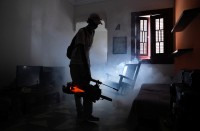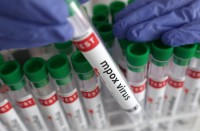by Ivan Couronne
Agence France Presse
WASHINGTON, United States (AFP) — US public health experts sounded the alarm Wednesday over a resurgence of measles in recent years, principally in communities where people reject vaccinations and obtain exemptions for religious or “personal” reasons.
Six outbreaks of the disease have been reported in the United States since January 1, totalling 159 cases, in the states of Washington, Colorado and New York.
Since 2000, between 50 or several hundred cases have been reported a year, even though the highly contagious disease was declared eradicated at the start of the century.
Its return is “really unacceptable,” said Antony Fauci, director of the National Institute for Allergies and Infectious Diseases, during a congressional hearing. “We need to get to zero.”
The virus is one of the most contagious known. It can linger in a room or on a surface for up to two hours after the infected person has left.
In most American measles epidemics, the virus has been imported by travelers returning to the United States, the disease being highly active in many other countries.
It then propagates among un-vaccinated people, who tend to live close to each other.
“There are pockets of people who are vaccine hesitant,” Nancy Messonnier, director of the National Center for Immunization and Respiratory Diseases (NCIRD), told the lawmakers.
In the past five years, 12 of the 26 US measles epidemics — an epidemic is defined as more than five people infected — occurred in “close knit communities,” she said.
Three quarters of the cases are concentrated in such communities. Examples include an outbreak in the Somali community in Minnesota in 2017, and in the Orthodox Jewish community in Brooklyn last year.
Disinformation
Disinformation about vaccines is a factor, the experts stressed, blaming social networks for spreading false information about the risks of vaccination. Recently, Facebook, YouTube and Pinterest, under pressure from Congress, announced measures to block anti-vaccine content.
The MMR vaccine against measles, mumps and rubella is “incredibly safe,” Messonnier said. Since it was created in the 1960s, millions and millions of doses have been administered, with sore arms the most frequent side effect.
“We are a victim of our own success,” said Messonnier.
As the number of measles cases has dropped by 99 percent since the 1960s, parents have become less attentive to the risks posed by the disease.
Measles once claimed 400 to 500 lives a year in the United States. Besides fever, tiny red spots and other symptoms, complications from the disease include ear infections (1 in 10 cases); pneumonia (1 in 20 cases); and encephalitis, an inflammation of the brain (1 in 1,000 cases).
To obtain “herd immunity” — in which unvaccinated people are protected by the high proportion of others who are vaccinated — requires vaccinating between 92 and 95 percent of the population, Fauci said.
The national rate of vaccination for children is at about that level, but there are big disparities among states, and from one city or school to another.
The exemptions
The most flagrant example of that is Clark County, a jurisdiction just north of Portland, Oregon, where 65 of 159 cases of measles in the United States are concentrated.
Fifteen years ago, 96 percent of five-year-old students in the county were vaccinated against measles. In the 2017-2018 school year, the proportion had fallen to 84 percent.
In some schools, especially private schools, the MMR vaccination rate was as low as 20 or 30 percent.
Washington state lawmakers have reacted by advancing legislation that would eliminate exemptions for personal or philosophical reasons. The opt-out for religious reasons would remain. Other states are also considering similar action.
In the United States, only three of the 50 states — California, Mississippi and West Virginia — allow exemptions only for medical reasons.
© Agence France-Presse







